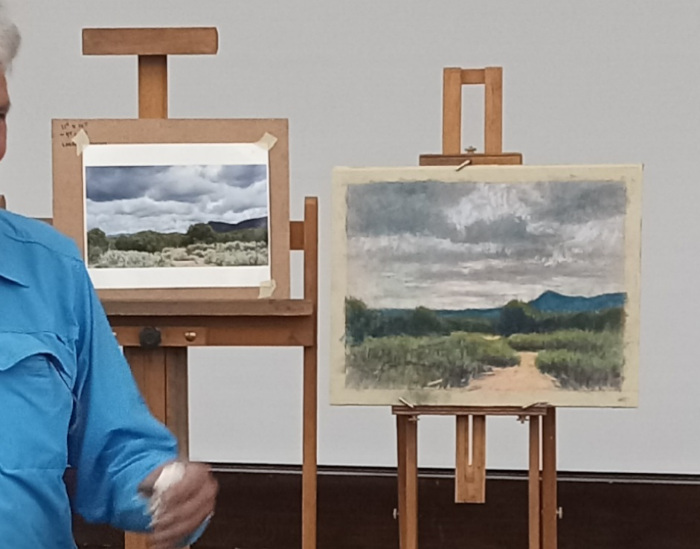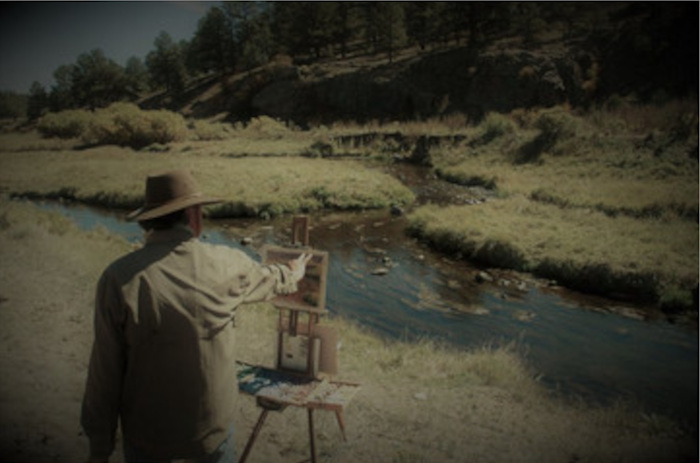

Upcoming Meetings
November 11, Cheri Ginsburg demo with PanPastel
New Brighton Community Center, Room 224, 7pm – 9pm
Cheri Ginsburg is an award-winning pastel, pen & ink artist, and sculptor. Ginsburg's extensive travels throughout North America, Europe, Costa Rica and parts of Africa, as well as her fondness for the American Southwest and home state of Nebraska, influence her work as she experiments with bringing her interpreted landscapes to life with exquisite color and detail. Her work is often recognized by a sense of tranquil serenity regardless of subject matter or medium. In her own words she says: “Having come from a background of stone and bronze sculpture; I was instantly intrigued by the hands on feel of working with pastel. Then, totally by accident, I discovered Pan Pastel while looking for a blacker black... and something clicked. The colors were yummy, I liked the ease of using the pallets, and the tools gave me that sculptural feeling I missed from my stone sculpting days. And then there was that soft effect I loved. And the rest is history.”
January 10, 2026 - 1pm-4pm - PAINT IN
Location: Creative Flow Art Center, 110 77th Way NE, Fridley
There will be plenty of natural daylight through the Firehouse doors from the northside! The space provided for the painting will have an ongoing exhibit up. The public may be coming in to view the exhibit as well as our group’s painting process. Come see what people are working on and get some new tips about techniques from fellow members. You may be witnessing the creation of the next winning painting for our 2026 judged exhibit! Don’t miss this opportunity.
March 10, 2026 - 7:00pm-9:00pm - Member Meeting
Artist Lisa Stauffer – “Critiquing Your Work and knowing when to stop ”
lisastauffer.com
Location: TBD 7:00pm – 9:00pm
May 12, 2026 - 7:00pm-9:00pm - Member Meeting
Artist Gail Sibley, Demonstration
gailsibley.com
Location: Christ the King Church, 8600 Fremont Ave S, Bloomington MN
July 14 - PAINT OUT
Location and time: Stay tuned for more information
September 8, 2026 - 7:00pm-9:00pm - Member Meeting - TBD
November 10, 2026 - 7:00pm-9:00pm - Member Meeting - TBD

Board meetings are held on the first Tuesday of every other month, beginning with January, from 5:30-7:00 via zoom.
Member meetings are the second Tuesday of the same month as the board meeting, from 7-9pm.
At our member meetings we feature guest speakers, demonstrations, materials and equipment information, critiques and exchanges of information and insight to further members' artistic development and our sense of community as a society.
Starting in 2026, to encourage attendance by our members from throughout the state, we will be holding our Member meetings in a variety of locations throughout the Twin Cities.

Past Meetings
October 14, Fred Somers demo
Location TBA somewhere in Northfield
Many of you know Fred, and for those who don’t, come to the demo and be totally enthralled. Fred Somers has been painting full-time since 1975 at his farm-home-studio near Northfield, MN. His oil and pastel paintings, known for their peaceful sensitivity, reflect themes from the land. Whether in intimate views of grass, rocks and water with reflections of light and sky, or in spacious vistas of the countryside he seeks to share the hidden places of nature. He has won too many awards to be listed here and he is now internationally recognized as a great pastel artist. Don’t miss it.
September 9, Kathe Drake demo on Still Life.
New Brighton Community Center, Room 224, 7pm – 9pm
Many people work with outdoor scenes, but have you ever tried doing a still life painting? Or even had questions about doing the background for it, objects to use, starting with an underpainting, etc. Come to this meeting and hear what options and techniques Kathe Drake uses when she does her still life paintings. Her presentation will include home marketing techniques, subject matter, background choices and more.
Kathe Drake is an award-winning pastel and oil painter. Like many artists, she has been creating art since childhood. She graduated from the University of Minnesota with a minor in art and furthered her studies at the Minnesota River School of Fine Art, where she went on to teach pastel painting. Most of Kathe’s work is created directly from life. She is particularly drawn to feminine subjects - women and their clothing as well as to flowers, fruits and vegetables. Even common place objects gain significance when carefully viewed and incorporated into her still life’s. She says “because the visual world is so rich with possibilities, I find there are endless variation to capture in all that I see.” Kathe’s work has been in several national and international shows. . She will have three of her paintings in the LCPS exhibit coming up at the Frameworks Gallery in Highland Park of St. Paul. So, do come to her presentation and learn more about Still Life painting.
July 8 Paint Out, Tuesday from 4pm – 7pm.
This coming July join us for our annual Paint Out, or you may call it our annual plein air event. We are planning our event just north of Forest Lake at Paradise Park. It is located in Chisago City. There is a beautiful lake, wonderful large trees, a beach, shelter, a children’s play area, and of course, bathrooms. You have many options to choose from for an outdoor scene. It will also be a great chance to learn from others about techniques and the process of preparation for outdoor painting itself. Directions are: (Think Taylor’s Falls) Take I-35 to County Road 8, and turn east driving past Wyoming to a street in Chisago City called Olde Towne Road. (Your GPS unit may refer to it as Benet Road.) Take a right turn to Stinson Ave., which is about a block, then you’ll see the sign for Paradise Park and a right turn into the parking lot. Hope to see you there.
Recap of May 15 Demo with Lorenzo Chavez
Lorenzo, our workshop artist, will be giving a live demo of his work and technique. Please note that this is Thursday, not our usual Tuesday meeting day.
Lorenzo Chavez was born and raised in the southern most point of the Rockies in New Mexico. His first inspirations and foundation as a young artist were formed by the local landscape and the art history in New Mexico. Using pastel and oil mediums, his hope is to carry on the art traditions of American painters such as the Taos Society of Artists and the American Impressionists.
Lorenzo is a nationally known Fine Art instructor who has taught numerous workshops across the United States since 1993. Lorenzo is represented by many major fine art galleries and many private and corporate collections both nationally and internationally. Currently there are nine art books featuring his works of art around the world. You don’t want to miss this great opportunity!



